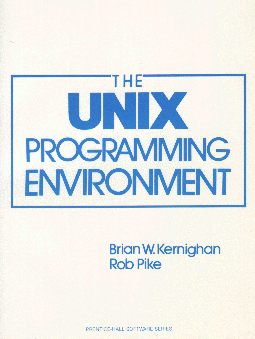Related Research Articles

Plan 9 from Bell Labs is a distributed operating system which originated from the Computing Science Research Center (CSRC) at Bell Labs in the mid-1980s and built on UNIX concepts first developed there in the late 1960s. Since 2000, Plan 9 has been free and open-source. The final official release was in early 2015.
Yacc is a computer program for the Unix operating system developed by Stephen C. Johnson. It is a lookahead left-to-right rightmost derivation (LALR) parser generator, generating a LALR parser based on a formal grammar, written in a notation similar to Backus–Naur form (BNF). Yacc is supplied as a standard utility on BSD and AT&T Unix. GNU-based Linux distributions include Bison, a forward-compatible Yacc replacement.
Lex is a computer program that generates lexical analyzers. It is commonly used with the yacc parser generator and is the standard lexical analyzer generator on many Unix and Unix-like systems. An equivalent tool is specified as part of the POSIX standard.
Limbo is a programming language for writing distributed systems and is the language used to write applications for the Inferno operating system. It was designed at Bell Labs by Sean Dorward, Phil Winterbottom, and Rob Pike.
The C programming language provides many standard library functions for file input and output. These functions make up the bulk of the C standard library header <stdio.h>. The functionality descends from a "portable I/O package" written by Mike Lesk at Bell Labs in the early 1970s, and officially became part of the Unix operating system in Version 7.

rio is Plan 9 from Bell Labs' windowing system. It is well known for making its window management transparent to the application. This allows running rio inside of another window manager.

The C Programming Language is a computer programming book written by Brian Kernighan and Dennis Ritchie, the latter of whom originally designed and implemented the C programming language, as well as co-designed the Unix operating system with which development of the language was closely intertwined. The book was central to the development and popularization of C and is still widely read and used today. Because the book was co-authored by the original language designer, and because the first edition of the book served for many years as the de facto standard for the language, the book was regarded by many to be the authoritative reference on C.
C dynamic memory allocation refers to performing manual memory management for dynamic memory allocation in the C programming language via a group of functions in the C standard library, namely malloc, realloc, calloc, aligned_alloc and free.

Inferno is a distributed operating system started at Bell Labs and now developed and maintained by Vita Nuova Holdings as free software under the MIT License. Inferno was based on the experience gained with Plan 9 from Bell Labs, and the further research of Bell Labs into operating systems, languages, on-the-fly compilers, graphics, security, networking and portability. The name of the operating system, many of its associated programs, and that of the current company, were inspired by Dante Alighieri's Divine Comedy. In Italian, Inferno means "hell", of which there are nine circles in Dante's Divine Comedy.

The Unix Programming Environment, first published in 1984 by Prentice Hall, is a book written by Brian W. Kernighan and Rob Pike, both of Bell Labs and considered an important and early document of the Unix operating system.
Concurrent computing is a form of computing in which several computations are executed concurrently—during overlapping time periods—instead of sequentially—with one completing before the next starts.
In computing, the producer-consumer problem is a family of problems described by Edsger W. Dijkstra since 1965.
hoc, an acronym for High Order Calculator, is an interpreted programming language that was used in the 1984 book The Unix Programming Environment to demonstrate how to build interpreters using Yacc.
In computing, a channel is a model for interprocess communication and synchronization via message passing. A message may be sent over a channel, and another process or thread is able to receive messages sent over a channel it has a reference to, as a stream. Different implementations of channels may be buffered or not, and either synchronous or asynchronous.

Robert Pike is a Canadian programmer and author. He is best known for his work on the Go programming language while working at Google and the Plan 9 operating system while working at Bell Labs, where he was a member of the Unix team.

Go is a statically typed, compiled high-level programming language designed at Google by Robert Griesemer, Rob Pike, and Ken Thompson. It is syntactically similar to C, but also has memory safety, garbage collection, structural typing, and CSP-style concurrency. It is often referred to as Golang because of its former domain name, golang.org, but its proper name is Go.
Newsqueak is a concurrent programming language for writing application software with interactive graphical user interfaces.
qsort is a C standard library function that implements a sorting algorithm for arrays of arbitrary objects according to a user-provided comparison function. It is named after the "quicker sort" algorithm, which was originally used to implement it in the Unix C library, although the C standard does not require it to implement quicksort.

cat is a standard Unix utility that reads files sequentially, writing them to standard output. The name is derived from its function to (con)catenate files . It has been ported to a number of operating systems.

Nim is a general-purpose, multi-paradigm, statically typed, compiled high-level systems programming language, designed and developed by a team around Andreas Rumpf. Nim is designed to be "efficient, expressive, and elegant", supporting metaprogramming, functional, message passing, procedural, and object-oriented programming styles by providing several features such as compile time code generation, algebraic data types, a foreign function interface (FFI) with C, C++, Objective-C, and JavaScript, and supporting compiling to those same languages as intermediate representations.
References
- 1 2 Winterbottom, Phil (1995). "Alef Language Reference Manual". Plan 9 Programmer's Manual: Volume Two. Murray Hill: AT&T.
- ↑ "Preface to the Third (2000) Edition". Plan 9 Manual. Murray Hill: Bell Labs. June 2000. Archived from the original on 2015-02-05. Retrieved 2012-10-29.
- ↑ Pike, Rob (2010). Origins of Go concurrency style. OSCON Emerging Languages Camp. Archived from the original on 2021-12-13.
- ↑ Pike, Rob. "Rio: Design of a Concurrent Window System" (PDF). Retrieved 8 March 2013.
- ↑ "thread(2)". Plan 9 Manual. Retrieved 2012-10-29.
- Flandrena, Bob (1995). "Alef Users' Guide". Plan 9 Programmer's Manual: Volume Two. Murray Hill: Bell Labs.
- Phil Winterbottom (1992-10-20). "Plan9 VM". Newsgroup: comp.os.research. Usenet: 1c1denINN441@darkstar.UCSC.EDU.